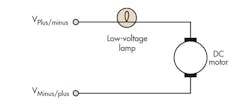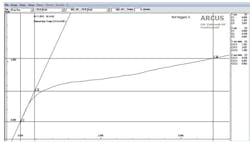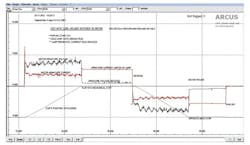This file type includes high resolution graphics and schematics.
A flap controller needs current limiting to protect the motor when the flap reaches full closure. A small incandescent lamp can perform this task without the need for more costly limit switches or a microcontroller.
A friend of a friend asked me how to best open and close a flap at the end of a tube: pneumatics, hydraulics, electrical, or what? It was an automotive application and no hydraulic system or compressor was available. So, the answer seemed obvious: a 12-V dc, small-gear motor.
The friend said he had tried that already, but he ran into problems with limit switches. The need for a constant closing force at the end of travel was another complication. Adding a microcontroller was too complicated, he said.
There seemed to be no simple answer. But eventually a solution came to me. And all it requires is a low-wattage, low-voltage incandescent lamp added to the motor circuit (Fig. 1).
1. A low-wattage, low-voltage incandescent lamp in the flap’s motor-control circuit eliminates the need for limit switches or a microcontroller.
The relationship between voltage and current in a small incandescent lamp is very nonlinear (Fig. 2). The tungsten wire in the lamp has a low resistance when cold. That’s in the region up to around half a volt. Cursors CI and CII indicate that the slope in that region is 0.439/1.267 = 0.35, while the slope between the origin and CIII (nominal voltage and current) is 2.12.
2. The lamp’s current-voltage curve (vertical versus horizontal) illustrates the nonlinearity that makes this solution possible.
So, the lamp acts as an automatically changing resistor with a low resistance when the load is low and a resistance six times higher when fully loaded. That’s exactly what we need to run an actuator withoutlimit switches, microcontroller, transistors, or whatever.
Figure 3 shows flap position, motor voltage, and motor current in a close/rest/open/rest/power-off cycle. The motor current’s variations (red trace) reflect a badly aligned coupling and noise in the commutator. That is always present in small dc motors. But the motor used in this application is worse than most other motors in that respect. Despite that, the movement (grey) is smooth and well-defined.
3. A plot of the circuit’s operation shows the smooth, well-defiend movement of the flap despite the variations in the motor’s current.
When the flap hits the mechanical stop (flap closed), the motor stops and the back electromagnetic field (EMF) drops to a low value, which means that current would have risen to perhaps five or 10 times the running current, depending on which motor and which supply is chosen. That, of course, would destroy the motor and is why limit switches and controllers are needed to switch off, or reduce, current.
By adding a simple low-wattage and low-voltage incandescent lamp to the circuit, you can avoid this problem and keep the motor current at a low level that the motor can tolerate indefinitely. You can even use the lamp as a visual indicator that the flap has reached its closed (or open) position. And, the reduced current needed to keep the flap tightly closed comes without even asking for it.
Gunnar Englund, electrical engineer, worked with ABB and Siemens for many years and is now an independent consulting engineer. He is mostly active in research and problem solving regarding EDM in bearings (bearing currents). He can be reached at [email protected].
This file type includes high resolution graphics and schematics.




